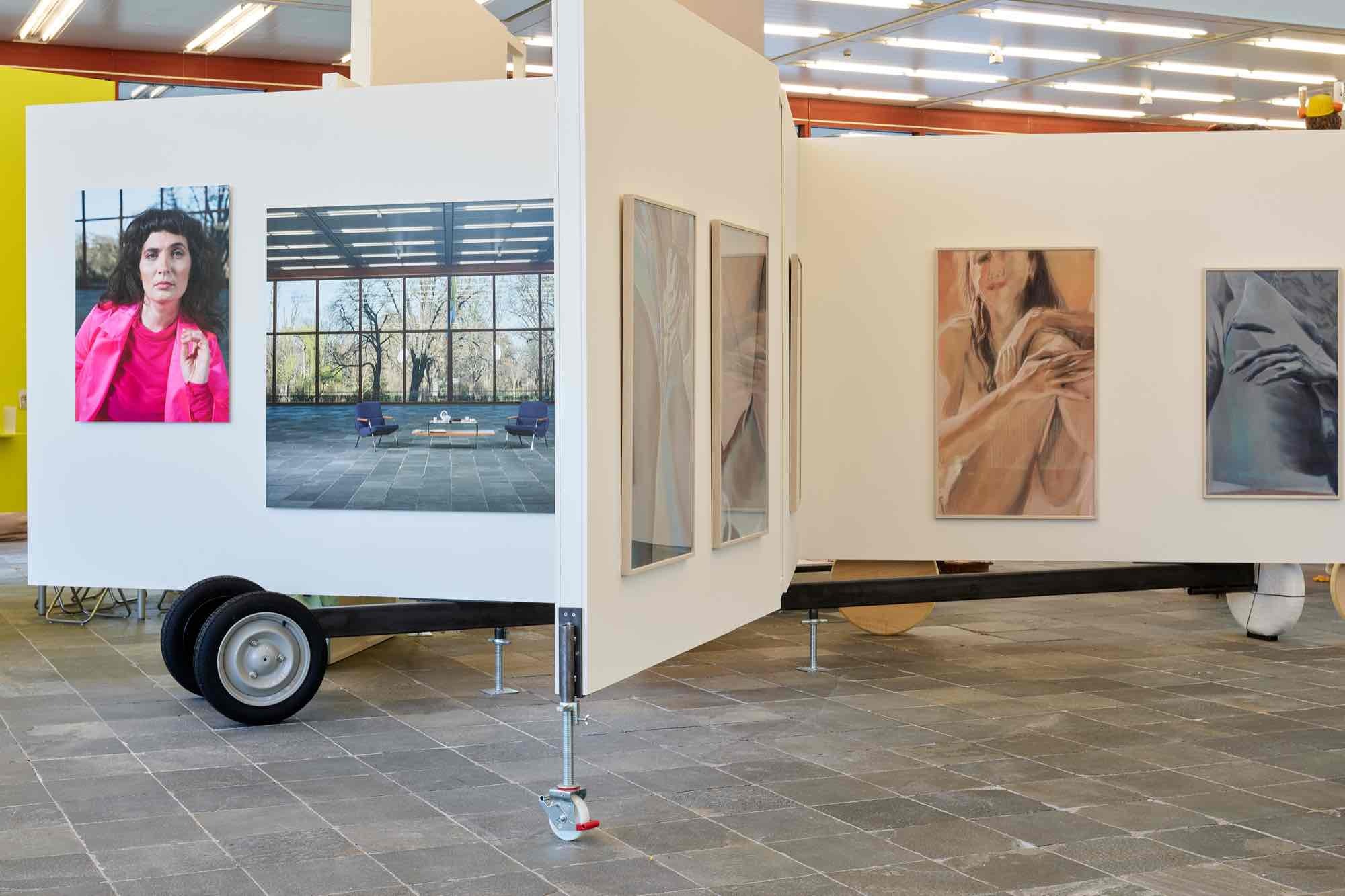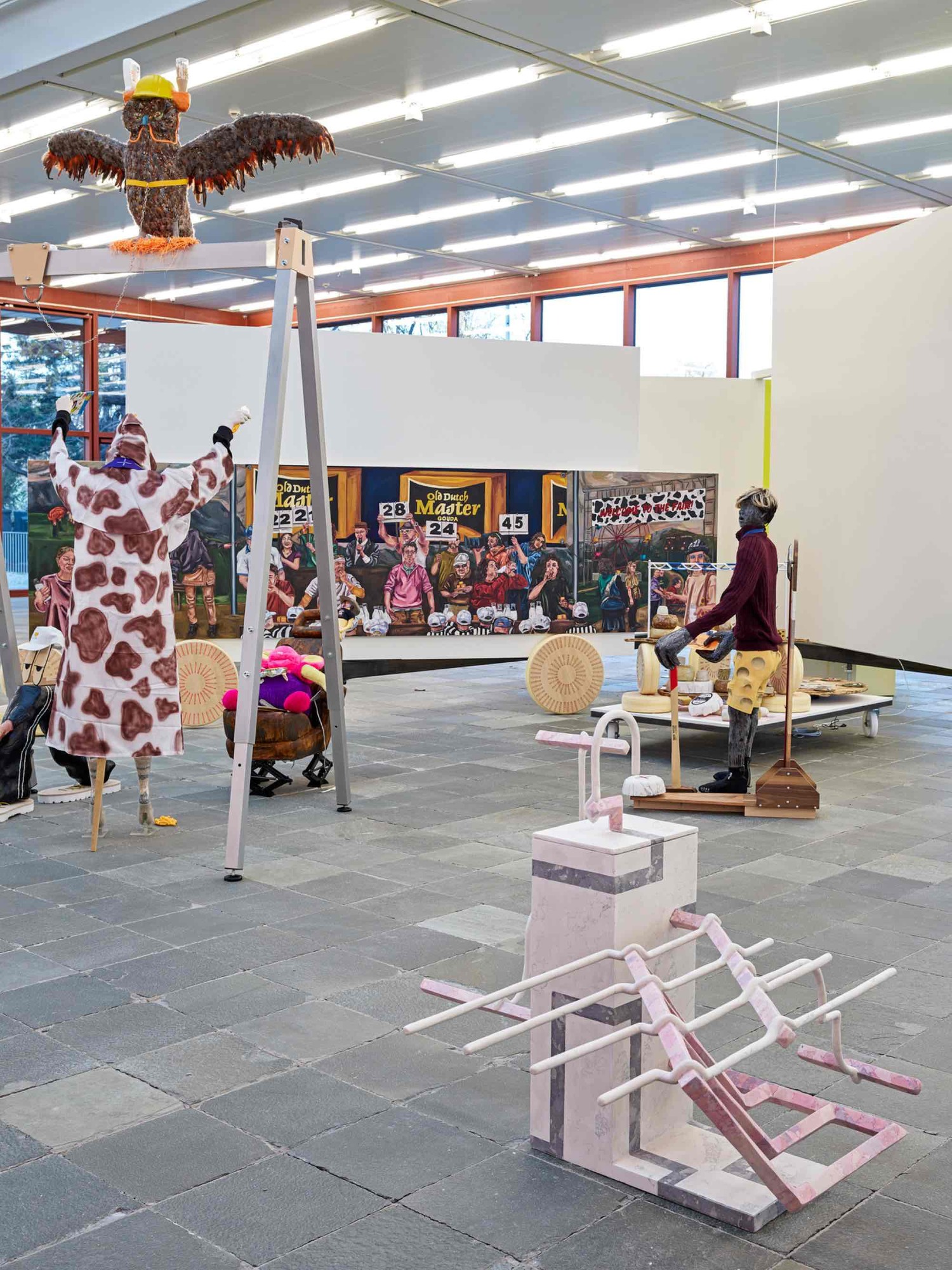On the New
Viennese Scenes and Beyond
07 Apr 2023 - 14 Jan 2024

Ana de Almeida, From Fat and the City, 2021–2023
100 handmade soaps, steel display;
soaps: glycerin, pigment, fragrances, archival footage, rubble
Courtesy: Ana de Almeida
Photo: Johannes Stoll / Belvedere, Vienna
100 handmade soaps, steel display;
soaps: glycerin, pigment, fragrances, archival footage, rubble
Courtesy: Ana de Almeida
Photo: Johannes Stoll / Belvedere, Vienna

Minda Andrén, "Perfect posture" of the series Do you like the dust we breathe, 2023
Oil and pigmented gesso on canvas
Courtesy: Minda Andrén and Zeller van Almsick, Vienna
Photo: Johannes Stoll / Belvedere, Vienna
Oil and pigmented gesso on canvas
Courtesy: Minda Andrén and Zeller van Almsick, Vienna
Photo: Johannes Stoll / Belvedere, Vienna

Flora Hauser, detail to: "OUSIA1", 2023
Acrylic fiber yarn on linen cloth
Courtesy: Flora Hauser and Galerie Meyer Kainer, Vienna
Photo: Johannes Stoll / Belvedere, Vienna
Acrylic fiber yarn on linen cloth
Courtesy: Flora Hauser and Galerie Meyer Kainer, Vienna
Photo: Johannes Stoll / Belvedere, Vienna
What is going on in local art scenes, studios, and alternative exhibition spaces? How can one exhibition capture the diversity of the production and presentation of art? The Belvedere 21 explores these questions in a three-part show.
General Director Stella Rollig: The anniversary-year theme, "Golden Spring," evokes new beginnings, awakenings, and the desire to shape the future. This attitude is reflected in the exhibition's vitality and many voices of artistic production. The diversity of practice by these artists offers a guide to the possibilities of facing reality with optimism despite the current challenges.
In joint curatorial authorship, a team of five curators has collaborated with numerous contributors to devise a dynamic format at Belvedere 21's main gallery. The exhibition takes up the concept of the 2019 exhibition On the New, Young Scenes in Vienna. However, the global situation has changed dramatically since then. The consequences of the COVID-19 pandemic are still being felt, and conflicts have escalated or resurfaced: the war against Ukraine, the situation of women in Iran, Black Lives Matter. Climate change and issues of racism and sexism have had a profound impact on the art and culture industry and artistic activity. How artists responded to these crises and upheavals was of great interest to the curatorial team in their selection process.
Following a feminist curatorial tradition, Christiane Erharter, Andrea Kopranovic, Ana Petrović, Claudia Slanar, and Luisa Ziaja were also concerned with filling gaps: Which positions are underrepresented in museums, and which are completely missing? These questions arose precisely because museum work is still centered around questions of representation.
According to the curators of the exhibition: Our selection of artists and art spaces aims to reflect the diversity of many scenes, strategies, genres, contents, and approaches. It resulted from a series of discussions among team members in which we attempted to sketch a sort of contemporary panorama. We believe it is critical to treat the different approaches and stances equally. As part of an expanded view of contemporary approaches, strategies, and discourses, artists and project spaces from Linz and Salzburg are included, while an excursion to art spaces in Bratislava will bring participants beyond the national border. The show comprises three consecutive parts and features a total of around forty-five artist positions and twenty-four art spaces that will curate their own alternating exhibitions within the exhibition. This dynamization multiplies perspectives on what art can be today, its themes, aesthetics, forms of expression, and the conditions under which it is created and perceived.
To accommodate this polyphony of expression, the Viennese architectural collective AKT developed a multifunctional and flexible exhibition design. Driven by the desire for collective participation, it challenges Karl Schwanzer's permeable and transparent but also static and masculine-modernist building. The art works and project spaces are spread across four mobile platforms in neighborly juxtaposition, allowing for connections as well as demarcations, yet always in new ways of interacting with the space at hand. The Viennese graphic design studio Beton responded with a specially conceived visual identity that further communicates the exhibition's three-part nature.
Curatorial team: Christiane Erharter, Andrea Kopranovic, Ana Petrović, Claudia Slanar, Luisa Ziaja
General Director Stella Rollig: The anniversary-year theme, "Golden Spring," evokes new beginnings, awakenings, and the desire to shape the future. This attitude is reflected in the exhibition's vitality and many voices of artistic production. The diversity of practice by these artists offers a guide to the possibilities of facing reality with optimism despite the current challenges.
In joint curatorial authorship, a team of five curators has collaborated with numerous contributors to devise a dynamic format at Belvedere 21's main gallery. The exhibition takes up the concept of the 2019 exhibition On the New, Young Scenes in Vienna. However, the global situation has changed dramatically since then. The consequences of the COVID-19 pandemic are still being felt, and conflicts have escalated or resurfaced: the war against Ukraine, the situation of women in Iran, Black Lives Matter. Climate change and issues of racism and sexism have had a profound impact on the art and culture industry and artistic activity. How artists responded to these crises and upheavals was of great interest to the curatorial team in their selection process.
Following a feminist curatorial tradition, Christiane Erharter, Andrea Kopranovic, Ana Petrović, Claudia Slanar, and Luisa Ziaja were also concerned with filling gaps: Which positions are underrepresented in museums, and which are completely missing? These questions arose precisely because museum work is still centered around questions of representation.
According to the curators of the exhibition: Our selection of artists and art spaces aims to reflect the diversity of many scenes, strategies, genres, contents, and approaches. It resulted from a series of discussions among team members in which we attempted to sketch a sort of contemporary panorama. We believe it is critical to treat the different approaches and stances equally. As part of an expanded view of contemporary approaches, strategies, and discourses, artists and project spaces from Linz and Salzburg are included, while an excursion to art spaces in Bratislava will bring participants beyond the national border. The show comprises three consecutive parts and features a total of around forty-five artist positions and twenty-four art spaces that will curate their own alternating exhibitions within the exhibition. This dynamization multiplies perspectives on what art can be today, its themes, aesthetics, forms of expression, and the conditions under which it is created and perceived.
To accommodate this polyphony of expression, the Viennese architectural collective AKT developed a multifunctional and flexible exhibition design. Driven by the desire for collective participation, it challenges Karl Schwanzer's permeable and transparent but also static and masculine-modernist building. The art works and project spaces are spread across four mobile platforms in neighborly juxtaposition, allowing for connections as well as demarcations, yet always in new ways of interacting with the space at hand. The Viennese graphic design studio Beton responded with a specially conceived visual identity that further communicates the exhibition's three-part nature.
Curatorial team: Christiane Erharter, Andrea Kopranovic, Ana Petrović, Claudia Slanar, Luisa Ziaja






